This article explores the critical role of a pick packer within the context of warehouse operations. A pick packer is responsible for selecting and preparing items for shipment, crucial to ensuring efficient supply chain management. Emphasizing precision and speed, pick packers play a vital role in maintaining inventory accuracy and meeting delivery timelines.

A pick packer is a key player in warehouse operations, responsible primarily for the task of collecting and packaging goods for shipment. The efficiency of a pick packer directly impacts the supply chain's effectiveness, as their accuracy and speed can determine how swiftly products reach their destination. In essence, pick packers serve as the vital link between the warehouse inventory and the customer’s doorstep, ensuring that the right products arrive on time and in good condition.
In many warehouse environments, the pick packer’s role is not merely about physical picking and packing. It also involves comprehending order specifications, maintaining an organized work area, and sometimes even contributing to inventory management and quality control processes. As consumers increasingly demand faster delivery services—sometimes within the same day—pick packers are becoming integral players in meeting these high expectations of service delivery.
The fundamental tasks of a pick packer involve picking products from storage based on an order list and packing them for dispatch. This role requires not just physical stamina but also a keen attention to detail, as any mistake in picking or packing can lead to delivery delays or customer dissatisfaction. Therefore, an expert pick packer must hone not only their physical skills but also their ability to comprehend and execute precise instructions.
The importance of accuracy cannot be overstated. Inaccurate shipments can lead to costly returns, lost customers, and damaged relationships between retailers and suppliers. Therefore, each step in the process—from selecting the correct item to close inspection during packing—must be executed impeccably. This necessitates a systematic approach to work, where each pick packer must be able to quickly navigate the warehouse layout and locate items efficiently while adhering to high standards of accuracy.
With advances in technology, the role of a pick packer has evolved significantly in recent years. Many warehouses now employ automated systems such as barcode scanners and inventory software to streamline the picking process. This integration enhances accuracy, reduces human error, and improves overall productivity. As such, familiarity with basic technological tools becomes crucial for modern pick packers.
Picking and packing systems often utilize software solutions that manage inventory in real-time. This means that as items are picked, the system immediately updates inventory records, ensuring accurate stock levels and reducing discrepancies. Additionally, automated guided vehicles (AGVs) and conveyor systems are increasingly being used to transport goods within warehouses, further enhancing efficiency. As such, today's pick packer must not only be adept at traditional tasks but also comfortable working with these advanced technologies.
Another emerging trend is the use of augmented reality (AR) in warehouse settings, which can display visual prompts to pick packers about where to find items and how to pack them, further reducing errors and speeding up the process. Robotics, while still developing in the sector, also promise to handle repetitive tasks, allowing human workers to focus on more complex aspects of the supply chain. As these technologies continue to advance, pick packers will need to engage with ongoing training and development to stay competitive in the workforce.
While starting as a pick packer might be an entry-level position, there is significant potential for career advancement. Experienced pick packers can move into supervisory roles, become warehouse managers, or specialize further in logistics and supply chain management. The skills acquired in this role are foundational and transferable across various sectors involved in inventory and distribution.
Career progression can also lead to roles in quality control, where pick packers may oversee the accuracy of packing processes and ensure that company standards are met to reduce error rates. In larger organizations, pick packers may have the opportunity to transition into roles that involve training and mentoring new employees, leveraging their experience to help develop the skills of others in the industry.
Additionally, with the growing importance of e-commerce, opportunities in niches such as online retail and third-party logistics providers (3PLs) are burgeoning. As warehouses adapt to the nuances of fulfilling online orders, workers who understand the complexities of rapid fulfillment will find themselves in high demand. Continuous professional development opportunities, such as obtaining certifications in inventory management or logistics, can offer further pathways for career advancement and specialization.
Pick packers face several challenges, ranging from managing inventory discrepancies to handling peak order periods. Managing inventory discrepancies can arise due to inaccurate counts, misplaced items, or theft. Solutions often involve employing proactive inventory management techniques, utilizing technology like RFID for inventory tracking, and implementing effective training programs to ensure everyone on the floor is well-prepared for high-demand situations.
During peak periods such as holiday seasons or post-sale events, the volume of orders can increase dramatically. Consequently, legislation surrounding labor practices must also be observed; this can include fatigue management and careful scheduling to maintain morale and productivity among workers. warehouse managers may implement shifts or staggered work hours in response to increased demand, ensuring that pick packers can meet targets without compromising their health and safety.
Another challenge is the need for ongoing training in technology use. As new systems are continually integrated, pick packers must keep up-to-date with the latest tools and software, meaning that ongoing training sessions and workshops should be regular practices within a warehouse setting. Firms that prioritize comprehensive training programs not only enhance their productivity rates but also improve employee satisfaction and retention.